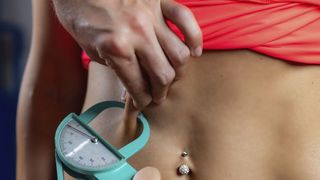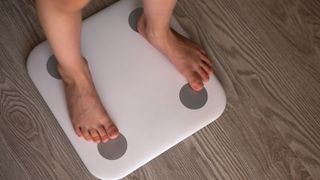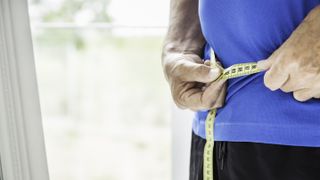How body fat is calculated
How body fat is calculated: how to measure body fat and why it’s important

Ever wondered how body fat is calculated? There are lots of ways to do it, including smart scales, calipers and the good old-fashioned tape measure. In this article we’ll tell you all about the different ways to calculate body fat, but first, why bother?
Being underweight or overweight, especially obese, can increase your risk of health problems, and it’s not just the amount of fat you have – it’s where it is on the body. The Mayo Clinic have found that belly (abdomen) fat is linked to a greater risk of diabetes, as well as high blood pressure, stroke and heart disease. If you fall into the latter category, the best exercise machines to lose weight can help you get in shape, as can regular exercise.
Body fat differs between males and females, and age and ethnicity are also important criteria, says registered dietitian Nigel Denby. “Whilst body fat can be an indicator of your health and fitness, it’s not the only factor you should consider. This measurement alone cannot determine your health status. If you’re concerned about your body composition, talk to your healthcare professional for support.”
Body fat, sometimes referred to as 'adipose tissue, also plays a crucial role to our wellbeing, explains Denby. It not only provides a store of energy, but it also insulates the body against the cold and protects our vital organs. “Our organs, such as the heart, are surrounded in a layer of fat, which cushions them against damage.”
“Without this layer of fat, our organs would be vulnerable to injury. A potentially less well known function of body fat includes the production of certain hormones, such as leptin, which is involved in regulating our appetite.”
There are many ways to assess the levels of body fat in the body, from manual calculations based on skinfold measurement to high tech dual energy x-ray absorptiometry (DEXA). “The reliability of these methods varies, with high tech options providing much more accurate results,” says sports psychologist Bryan Byrne from Profectus Performance.
Skinfold caliper

These handheld tools are inexpensive and widely available. They work by pinching and measuring the subcutaneous (under the skin) fat in different areas of the body, including the tummy, thighs and arms.
“This method can be uncomfortable and invasive,” says Denby, founder of the online Menopause Support Community Harley Street At Home. “Not only this, but it requires specialized training and a knowledge of anatomy to get accurate results.”
Smart scales

Smart scales, or body composition scales, are very accessible and widely available. They work by sending a very low level electrical current from the four inbuilt metal electrodes through your body. For that reason the scales shouldn’t be used if you have a pacemaker or osteoporosis.
This electrical signal passes through tissues that contain a large amount of fluids and electrolytes like muscle and blood, and then it faces resistance (known as impedance) when it passes through fat. The scales measure the impedance to work out body fat.
There are a ton of these high tech scales on the market, with varying levels of accuracy. “This method is highly influenced by hydration status as poorly hydrated fat-free tissue will have an increased resistance and may result in a higher than predicted value,” says Byrne.
Denby adds: “One study (published in the JMIR mHealth and uHealth journal) found that the position and size of feet on the scales could alter results. However, for someone who just wants a rough idea of their body composition, smart scales are a good start since they’re non-invasive, inexpensive and easy to use.”
Circumference measurements

Denby says: “Waist circumference or hip-to-waist ratio measurements are the most inexpensive way to calculate body fat, and only require a tape measure. This is used to measure around the waist and hips, and therefore doesn’t require excessive training.
“Circumference measurements are also suggested to be reliable indicators of health risk, since greater abdominal fat is linked to increased heart disease risk. However, accuracy can be lacking if measurements aren’t consistently taken in the same place.” A study published in the American Journal of Clinical Nutrition shows that “there’s debate that the hip-to-waist ratio is a more reliable measure of body composition than waist circumference alone.”
Dual-energy X-ray absorptiometry (DEXA)
Research published in the National Library of Medicine shows that DEXA is a reliable tool for calculating body fat. Byrne says: “Dual Energy X-ray absorptiometry (DEXA) is a highly accurate tool for measuring body composition. The DEXA Scan uses two low energy X-ray beams with short exposure to radiation to penetrate the bone and soft tissue areas to a depth of approximately 30cm. DEXA scans provide a high level of accuracy when assessing bone mineral composition as well as body fat and lean mass levels within the body.”
Denby adds: “DEXA or DXA is known as the ‘gold standard’ for measuring body composition. In an ideal world, DXA would be used exclusively, however this machine is expensive to operate and not very portable. It could be argued this method provides radiation exposure, but the amount is minor. In comparison to skinfold calipers, this method isn’t invasive, but may feel daunting at first.”
Hydrodensitometry

Also known as underwater weighing, hydrodensitometry was considered the gold standard for measuring body composition before more advanced techniques, such as MRI and CT scans, were developed.
Byrne explains: “To perform the test, the participant will wear a thin nylon swimsuit and will sit in a light plastic tube chair and are then completely submerged in water. The calculation of weight from this method takes into account the weight of the chair, the swimsuit and the volume of air in the lungs to ensure a more accurate measurement.” According to research published in the BMJ, “this has been found to be a valid and reliable method of calculating body volume and body fat.”
Denby says: “Whilst relatively accurate, this method can make individuals nervous if they’re not keen on water, since you’re required to completely submerge into the water. Not only this, but this method is expensive to operate and isn’t easily accessible to most individuals, since training is also required.”
Air displacement
“Air displacement, also known as plethysmography, uses an enclosed 750L pod that measures the total displacement of air when a person is inside,” says Byrne. “First the pod will measure the total air when closed and empty, then again when the individual is inside the pod. The person will take two to three breaths inside the pod to establish lung volume, which can be subtracted from the final result.
According to a study published in the BMJ, “this method of assessing body fat has been shown to be more effective than hydrostatic weighing when assessing body volume and showed an equal level of reliability with body fat assessment in adults, though not with children.”
Denby adds: “Those who dislike small spaces may find this claustrophobic. Clothing worn can also alter result accuracy. One study suggested this method’s accuracy varied upon the individual’s body composition status: more lean individuals had body fat overestimated, while those with obesity had body fat underestimated. This method isn’t widely available and is expensive.”
Best way to measure body fat
So now we’ve looked at the different ways to calculate body fat, which one is the best? Byrne says: “While the high-tech methods for assessing body composition are more accurate than manual ones, they may be cost prohibitive and accessibility may be limited.
“Skinfold and circumference method doesn’t provide the most accurate result, but taking subsequent measurements can track differences in body fat and body fat distribution, and may be a powerful combination in tracking changes over time.”
“Smart scales are readily accessible but fall prey to issues with hydration, so as long as hydration status can be ensured then this may also work to monitor body composition, however, it is still not seen as accurate for assessing absolute body fat percentage.”
Further reading
Accuracy of Smart Scales on Weight and Body Composition: Observational Study.
Metabolic syndrome - Symptoms and causes
A hydrostatic weighing method using total lung capacity and a small tank
Sign up for the Live Science daily newsletter now
Get the world’s most fascinating discoveries delivered straight to your inbox.
Maddy has been a writer and editor for 25 years, and has worked for some of the UK's bestselling newspapers and women’s magazines, including Marie Claire, The Sunday Times and Women's Health. Maddy is also a fully qualified Level 3 Personal Trainer, specializing in helping busy women over 40 navigate menopause.

